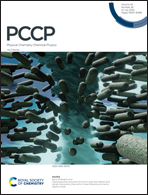Molecular vibrational spectral simulation connects theoretical cluster structure identification and vibrational spectral evidence†
Abstract
Structure identification of molecular clusters has long been a fundamental and challenging issue for cluster science. The traditional theoretical optimization on the potential energy surface heavily depends on the levels of theory and sometimes diverse identifications were reported. A solution to these disputations is to reinspect the theoretical results with the experimental data such as vibrational predissociation spectra with high sensitivity to the molecular cluster structures. Herein, the combination of global low-lying structure search and vibrational predissociation spectral simulation is proposed as an accurate and reliable approach for cluster structure identification, by which the assignments can be validated using experimental measurements. The qualitative agreement between simulated and measured vibrational spectra lends solid experimental evidence to the assignment of the cluster structures. Taking NH4+(H2O)n (n = 2–4) as an example, we have unambiguously identified their structures and directly demonstrated the coexistence of two NH4+(H2O)4 isomers (with 3 and 4 water molecules directly linked to NH4+, respectively), which were debatable in previous studies. The developed methods would pave the way to the structure determination of the molecular clusters.



 Please wait while we load your content...
Please wait while we load your content...